Types of heating a country house: comparison of heating systems by fuel type
All existing types of heating for a country house can be classified both by the fuel used and by the method of heat transfer.There is no single principle by which they are selected.
The efficiency of home heating depends on the climate in the region, the size of the house, personal preferences, and other factors. In this article we will look at heating with wood, blue fuel and electricity. Let us highlight the main advantages of each option. We will also talk about the types of heating equipment needed to implement each heating system.
The presented material is supplemented with visual diagrams and photo illustrations. To fully understand the essence of the issue, we have selected a thematic video on organizing autonomous heating.
The content of the article:
Wood stove for home heating
The principle of operation of a wood-burning stove is simple - when fuel burns, it releases heat. The walls heat up and give off heat to the air in the room. Stove heating, like any other, has its pros and cons.
Notable benefits of a wood stove include:
- a special cozy atmosphere that no other type of heating can create;
- relatively small financial investments;
- the ability to make it an original element of the interior;
- environmental friendliness, availability of fuel.
At the same time, the furnace takes up useful space and has low efficiency. The larger the house, the larger this heat source will be.Before heating the air in the room, you need to load firewood into the firebox, then repeat this procedure periodically.
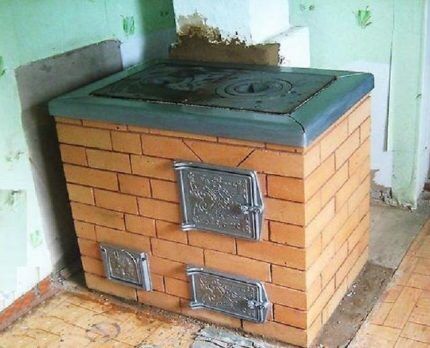
It is necessary to wait until the fuel burns well and warms up the structure. Only after this ritual will the long-awaited warmth spread throughout the room.
Types of wood stoves
Traditional wood burning ovens are made of bricks. The presence of serpentine chimneys in them allows you to heat the air in the room well and retain heat for a long time. It can be used as a fireplace and cook food on its surface.
There are 3 categories of brick kilns:
- With stove or heating and cooking. They can heat several rooms at once, and also cook food on them.
- Russian. As a rule, this is a massive structure with an appendage in the form of a couch. On such a stove they not only cook various dishes, but also dry herbs, fruits, and mushrooms.
- Stove-fireplace. In addition to the heating function, this structure is designed to decorate the interior, bring to it a touch of romance and special home comfort.
Wood-burning stoves are also made from cast iron. They are compact, so they will fit into any corner of the house. Combustion products are usually removed through a corrugated chimney. Such stoves allow you to quickly warm up a room.
Heat-resistant steel stoves also quickly warm up the air in the house. But the comfortable temperature does not last long. Sometimes stainless steel is used to make metal wood-burning stoves. It retains heat longer, but the seams do not withstand rapid heating well and are often damaged.

It is permissible to heat a country house with wood even without the obligatory construction of a stove in its direct sense. Pyrolysis boilers such as the Butakov furnace or Buleryan. The last option can be made with your own hands. Although here the fuel is wood, the principle of operation is different - similar to a gas generator.
Heat enters the room during post-burning. For this purpose, firewood is laid in large quantities. A mode is set in which only part of the wood burns, while the other part smolders. The duration of the process depends on the volume of the room and the power of the heating equipment. The efficiency of pyrolysis furnaces is quite high - from 75 to 85%.
Gas-generating furnaces also include the Strupov and Bubafonya furnaces, which operate without loading for up to 48 hours. Characteristic of these structures is the presence of a high column. Firewood is placed in it almost to the edge and set on fire, like a fire, from above.
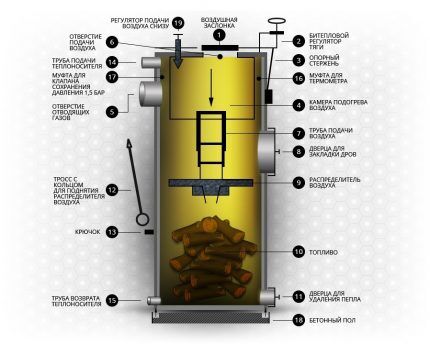
Instead of firewood, you can put in the stove sawdust, peat or other type of solid fuel. The denser it is laid, the longer the process will take.
The combustion process is supported by air supplied through a telescopic pipe at the top of the stove. The fuel burns, and the combustion zone gradually descends, along with the pipe supplying air, to the level of the grate.
As an alternative to heating a country house with wood, there are other solid fuel options such as pellets. Compared to firewood, they burn longer.Pellet boilersin which they are burned are safer, because protected from overheating, equipped with flame control.
On one load the boiler can operate for at least 3 hours. If the system is supplemented with a heat accumulator, the heat will accumulate and then enter the room.
For a small country house, one stove is enough to heat it and cook food. If the house is large, you need a carefully thought-out heating system, where one stove heats the entire building. For this purpose, steam or water circuits are installed.
In a one-story house, the circuit is connected to an ordinary brick stove or to a purchased cast iron one. If the mansion has 2-3 floors, you need to purchase a cast iron stove-boiler.
Improving the characteristics of stove heating
The water circuit improves traditional stove heating by significantly increasing the heating area and rational heat distribution. The heating process includes both the furnace walls and smoke channels, as well as the coolant itself. Heat enters the radiators when the wood is burning, but the heat remains in them for some time.
The inclusion of a conventional wood stove in a water heating system requires the presence of a heat exchanger. Its purpose is to warm up the water and ensure the circulation of the coolant.
The heat exchanger is made from sheet steel or metal pipes. Its sizes are individual. The main thing is that when installing, leave a gap of 10 - 15 mm between the register and the walls of the furnace, taking into account expansion.
If there is a second floor in the house, the system includes electric pump. It circulates the coolant more intensively, accelerating the heating process when lighting the stove. The system can also include a container to create a supply of hot water.
Heating a house with electricity
Heating a house with electricity is based on two principles. The first is heating each room separately using devices connected directly to the electrical network. The second is indirect heating with pumping coolant that heats the radiators in each room.
An example of a direct heating method is the use oil cooler. With its ribbed shape it resembles a classic cast iron battery. The device itself heats up to a high temperature and sends heat into the environment in the form of heat rays.
The surface of the radiator cools slowly due to the fact that the coolant has good thermal inertia. The most commonly used devices are additional ones. It is not economically profitable to include oil radiators in the main system.
Option #1 - using an electric boiler
The water system connected to the electric boiler has its own characteristics. To use electricity rationally, the coolant circulation in the system should only be forced. Natural circulation will increase energy consumption.
In addition, this will entail uneven heating of the room, a decrease in the rate of heat transfer, and power loss.

When using an electric boiler, the system must include an expansion tank equipped with a control unit and safety elements.The design of an open system does not make sense, because will lead to high operating costs.
To be able to heat your country house with electricity, you must have a power line of sufficient power. Therefore, before purchasing a boiler, you need to perform simple calculations.
You need to proceed from the fact that, according to experts, 1 kW hour is enough to heat a room of 10 m². If you have to heat 200 m², you will need 20 kW. Since, in addition to the boiler, there is other electrical equipment in the house, about 5 kW is added to the calculated value.
Type No. 1 - electric boilers with heating elements
In electric boilers, heating elements, electrodes, and magnetic induction are used as a working element. The first type is the most common. Water or other coolant is heated inside the boiler from the walls of heating elements enclosed in a moisture-proof housing, then goes into the heating system.
The efficiency of such a boiler is not very high - the heat transfer process is accompanied by large losses. A boiler equipped with a multi-stage connection and electronic control is considered more efficient. When the set temperature is reached, the boiler unit turns off.
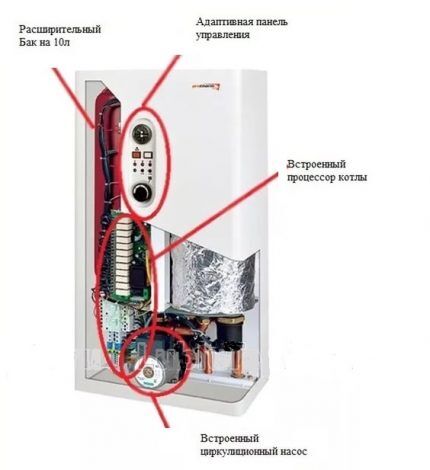
The main disadvantage of an electric boiler with heating elements is the formation of plaque on the heating element coils. Because of this, power consumption increases while efficiency decreases.
Type No. 2 - electrode units
The main feature of these boilers is that they do not have an element that heats the coolant. Heating occurs when electrical impulses transmitted by a special electrode pass through the water.
As a result of this effect, water molecules break down into ions that carry a positive and negative charge. Since this uses alternating current with a frequency of 50 Hz per second, the polarity of the electrodes in the aquatic environment changes at the same frequency.
Under such conditions, ions begin to vibrate and change direction. All this happens with great resistance of the aquatic environment to this process. As a result, thermal energy is generated, which the coolant transfers to the heating radiators. At the same time, hard deposits do not have time to settle on the electrodes, which is a big plus in favor of boilers of this type.
There are single- and three-phase boiler models. The only difference is in the design of the electrodes and dimensions. The design includes a cylindrical all-metal body coated with polyamide. The cylinder has pipes through which the coolant enters and exits.
The efficiency of ion boilers is high - from 95 to 98%. They are small in size and heat up very quickly, but also cool down at the same speed. The boilers do not have a “dry run”, so if there is no water in the system, they simply will not start. They are not affected by voltage drops; when it drops, the power simply decreases, but the unit does not completely shut down.
The disadvantages of boilers of this type include their increased demand for coolant. Water must have good conductivity, otherwise the power of the equipment begins to decrease.
Such a boiler will not be able to operate on battery power, because... Only a variable power supply is required. When operating it, it is necessary to prevent air from getting inside the boiler, because this triggers an enhanced corrosion process.

Single-phase units have a power of 2 - 6 kW, three-phase - 9 - 50 kW. The former are suitable for use in country houses, while the latter are used for heating large industrial buildings. The average diameter of the boiler is 32 cm, the maximum length is 0.6 m. The lower the temperature of the water inside the boiler body, the less electricity it consumes.
Depending on the principle of coolant distribution, electrode boilers can be open or closed. In the first case, natural circulation is carried out, and in the second, an expansion tank and pump are included in the system.
Most models have automatic control, a starting unit and protection against unstable power supply. Expensive models are equipped with a controller that maintains optimal temperature and remote control.
When installing an electrode boiler, you need to ensure reliable grounding of the electrical network at home. The boiler heat exchanger must be cleaned once every 12 months. It is also necessary to monitor the chemical composition of water and correct it if necessary.
Type No. 3 - induction equipment
The operation of an induction boiler is based on the principle of electromagnetic induction. The electromagnetic energy generated by the coil is transformed into heat. The core is heated by the electromagnetic field of the coil, and it transfers the resulting heat to the fluid passing inside it.
The boiler is used in both open and closed systems, in which coolant circulation is forced.
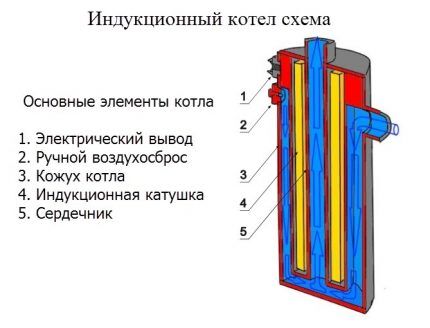
Boilers of this type are massive. Their housing contains a primary winding coil that is not in contact with the coolant. The secondary winding is an internal system of pipes with liquid flowing through them. Energy is not lost during the very rapid heating process, therefore, as manufacturers claim, the efficiency is close to 100%.
As a result of self-induction, the boiler additionally generates significant reactive power. This increases the efficiency of the equipment. Any coolant can be pumped into the system - both water and antifreeze, oil, glycerin. The cost of boilers of this type is quite high, but if desired, you can make an induction boiler with your own hands.
The heating system with an induction boiler, in addition to the heater itself, includes:
- circulation pump;
- membrane tank;
- heating radiators, and sometimes heated floors;
- security group;
- remote control.
Mount the boiler in a vertical position. At the same time, the distance to the nearest objects is at least 0.3 m on the sides and 0.8 m below and above. They start it only when the system is full and checks for airing. It is also necessary to ground both the boiler itself and the components of the system: controller, pump and other elements.
Option #2 - heating with electric convectors
Visually, a convector is the same battery located under a window or on a wall. But there are heating elements inside. The design provides for the penetration of cold air inside from below. It heats up inside and comes out through the top grill.
The user sets the temperature himself.Thermostats built into the convector control the temperature and turn off the device when it reaches the set value. The advantage of heating using convectors is the absence of the system itself with its complex wiring and “bonuses” in the form of freezing or leakage.
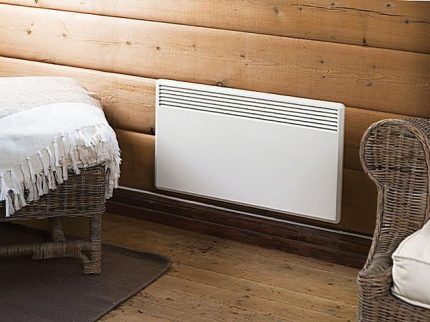
Since these heating units do not have open elements, and the outer panel heats up only slightly, they are completely safe. They operate silently, and the design allows them to be used without damaging the interior. They produce mobile and stationary convectors, which allows you to create comfortable zones with their help.
We have provided a rating of the best manufacturers of electric convectors for home heating and recommendations for choosing In this article.
Option #3 - heating the house with warm floors
You can also heat a private house from the mains using heated floors.
They are produced in several versions:
- Cable single or double core. They are usually placed in a screed, which then accumulates heat and releases it into the surrounding atmosphere.
- In the form of heating mats. Essentially this is the same cable, but located on a fiberglass mesh. For their installation, a screed device is not a mandatory requirement.
The design of the heated floor provides for the presence of temperature sensors. The heating mode is maintained automatically after pre-setting the temperature. The room warms up evenly.
Information on installing cable and film versions of heated floors is described in detail in the next article.
Option #4 - infrared space heating
A comfortable microclimate is created by long-spectrum waves transmitted by an infrared heater. It first heats everything in the room, and only then the excess heat enters the air. Heat is located near the floor, and not at the top, as with convector heating. This regime is most favorable for all inhabitants of the house, including plants.
There are 3 types of IR heaters:
- ceiling;
- floor;
- wall-mounted
The former can become an element of a suspended ceiling, and if you place the IR above the window, it will cut off cold air. The direction of radiation is adjusted using special suspensions.
Floor models are mobile. They can be moved to any desired place or taken with you into nature. Wall-mounted IRs are involved in creating the interior. They can disguise themselves as a panel, a painting, or a wall lamp.
The most convenient to use are PLENs or film electric heaters. They are strips of heat-resistant transparent film with a maximum thickness of 0.4 mm in different sizes. The emitters are placed between layers of plastic and connected to each other via conductive copper busbars.
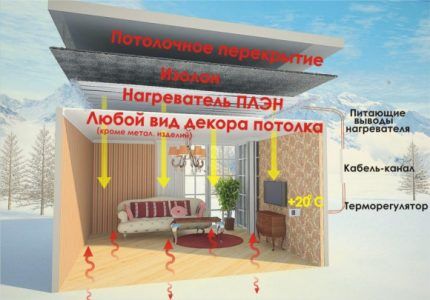
The film is sometimes used as a heated floor without screed. It itself warms up to an average of 50⁰, so it cannot burn or cause a fire. The disadvantage of an infrared heater is its constant glow.
Gas for home heating
This type of heating leads both in popularity and cost. Main gas is especially beneficial in this regard, but it is not always available in suburban settlements.If we consider this case, then a good solution for gas heating of a country house is the use of gas tanks. This option is not the cheapest, but still cheaper than electricity.
To install a heating system, you need a project, after which a boiler is selected.
Several factors are taken into account:
- Purpose. The boiler can be used purely for heating and then a single-circuit option is suitable. When it is necessary to provide hot water supply, a double-circuit boiler is chosen.
- Installation method. For a house with an area not exceeding 200 m², a wall-mounted version is suitable. For larger buildings, a floor-standing boiler is needed.
- Type of heat exchanger. It is made of steel, cast iron, copper. Copper is more often used in wall-mounted boilers, cast iron and steel are used in floor-standing boilers. The latter are more durable.
- Smoke removal. As a rule, it leaves through the chimney, which creates natural draft.
If the heating system is connected to cylinders filled with propane-butane, you can use the same main boilers after a little modernization. Here you just need to change the burner, which is often included in the kit.
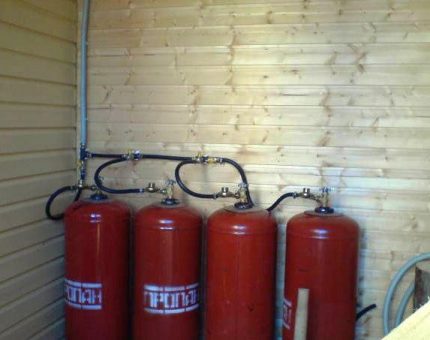
To get the maximum amount of gas from a cylinder, you need to purchase a boiler with a lower gas pressure.
The best solution is to connect several cylinders. This way you can change gas supply sources less frequently. The pressure in such a gas pipeline is always stable and this is a great advantage of an autonomous gas supply.
Are you most attracted to the option of using gas as a fuel? In this case, we recommend that you familiarize yourself with detailed information on autonomous gasification private house.
Conclusions and useful video on the topic
Economical option for autonomous heating:
Having enough information about different methods of heating a country house, you can choose the most suitable option. In addition, a combination of different types is permissible in one building. A good solution is a multi-fuel boiler that allows you to use the available types of fuel most efficiently.
Are you choosing the right heating option based on the most available type of fuel in your region? Maybe you still have questions after reading our article? Or do you want to supplement the material with useful information? Ask questions, write your advice and comments - your opinion is important to us.





Quite informative. I didn’t know about the existence of electric heating, I think this method of heating will instantly rip off half of your monthly salary if you are a simple hard worker. But if there are bills coming out of your pocket, then you can try. I think that heating with wood is the most effective and not particularly expensive method. I use a wood stove myself, no problems.
Hello. Let's do some rough math. Heating a house of 43 square meters with 2 kW and a tariff of 4 rubles costs about 6 thousand rubles per month with an electric boiler - 30%, since we are included in the preferential category of citizens (I don’t count it right away, since not everyone is included).At the same time, the installation of heating with pipe development (suitable for gas connection in the future) and natural circulation cost a total of 15 thousand rubles.
Gas connection - 250 thousand, for some the amount is completely different, depending on the region, gas workers’ calculations, and so on (-50% regionally for the benefit, but again, we don’t count). The difference with electric is 235 thousand rubles (not counting equipment).
I don’t remember the gas tariffs in that area, but the approximate payment per month is 2 thousand rubles for heating. 6-2=4 thousand difference. It turns out that without connecting gas, we could heat the house for 4 years for the difference in the cost of connection. Not counting maintenance (if we are talking only about the boiler, it is not much, 400 rubles per year). But this does not mean that you should strive for electrics. In 4 years, gas will become so expensive that an electric boiler will cost more. It was simply a necessity for such a connection.
Now for the firewood. A machine of chopped wood costs 10 thousand rubles (in our region). The car lasts for the heating season - 4-5 months. This costs approximately 2 thousand rubles per month. To build a stove - 150 thousand rubles (prices vary regionally).
It turns out that stove heating is the most profitable if the connection does not exceed millions. But for the time being, until the gas connection pays off (and for some it costs no more than 100 thousand + equipment, and sometimes it’s cheaper). And the stove needs to be constantly monitored and cleaned. So everything is individual here.
Quite informative, but I think half of these methods are very expensive. Heating with electricity is too expensive. I tried to heat my private house in different ways.I even used the stove during detention, I could go crazy, the constant stench from this junk was too unbearable a side effect of my attempt to save money. I prefer to heat with either wood or gas. But perhaps the other methods listed above are also very relevant, albeit expensive.
During the construction of a country house, we finally managed to realize a long-standing dream - to acquire a fireplace. This is not only a decorative option, but also an economically feasible solution. The house is heated in a couple of minutes and does not require much effort. Fortunately, firewood is everywhere in our area. All that remains is to make physical efforts. There is a considerable amount of money spent on housing and utilities in the city; there was not enough money to spend here.
Hello. In a conventional fireplace, the chimney is always vertical, with the possibility of slight deviations and the damper closing only after the wood has burned out. The walls of the fireplace are not a stove, they do not warm up, that is, the heat comes exclusively from direct fire. A friend of mine tried for 5 years to heat a 43 square meter house using only a fireplace. Despite the fact that the house is perfectly insulated and you can sleep on the floors in winter, there is not the slightest draft. The efficiency of the fireplace (new) is no more than 30% and while the coals are burning, if there is no screen, especially since the heat goes into the chimney. You cannot melt it at full power - the furnace will burst. It's not worth bothering with so much. Unless you can grill kebabs all year round :))
I completely agree with both Daniels (it’s a coincidence) that when heating a house with electricity, the only thing you’ll worry about is paying crazy amounts of money for electricity.Since childhood, I grew up in an area where the only type of heating was wood, and every house had a stove. And although there was a sea of forests around and firewood was relatively inexpensive, but dear mother, how troublesome it is to light the stove every single day.
For relatives from the city who came to visit, it was exotic, pleasure and entertainment; they willingly helped, they even did it with pleasure, but for us it was an ordinary concern and trouble. But the living warmth from the stove is something, I agree, you can’t argue with that. Now I live in a house where there is a gas boiler, I turned it on, set the temperature and you don’t know any grief. And it’s cheaper than an electric one. I think that gas heating is the best option.
Luka, gas, of course, is an ideal option, but it is not available everywhere. For example, holiday villages - they are fundamentally not gasified, but people live there even in winter.